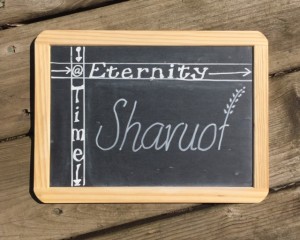There is one point at which the Jewish festal calendar and the Christian calendar intersect, and it is Shavuot, also known as Pentecost. This year, the Jewish people will celebrate Shavuot (shah-voo-OAT) beginning at sundown on Saturday, June 11th. You’d be right in wondering how Shavuot and Pentecost align since the Western Church celebrated Pentecost on May 15th, and the Eastern (Orthodox) Church marks the day this year on June 19th.
While the dates may diverge, Shavuot is the closest spiritual connection point between the lunar-based Jewish calendar prescribed by God in Leviticus 23 and the lunar/solar hybrid calendar worship cycle developed by the early Christian church. Shavuot was originally a celebration of God’s care through his provision of the fruit of the earth – grain. After the destruction of the temple in Jerusalem, the people could no longer fulfill the specific requirements, religious leaders found ways to honor Shavuot’s original emphasis while shifting the focus to rejoice in God’s gift of the Law to the people at Sinai.
I’ve been in Jerusalem twice on Shavuot (so far, Lord willing!), and I remember the joyous summery way in which this Sabbath-for-all holiday is celebrated – flower-wreathed women and dairy treats for everyone, and an all-nighter for observant Jews, who stay awake studying the Law as a sign of their gratitude. Shavuot may not have the cultural recognition as does other Jewish holidays like Chanukah or Passover, but it is for us as believers in Jesus the Jewish Messiah a day given to honor God’s physical and spiritual provision to us as well as the way in which the Holy Spirit was poured out, immersing us in himself in order to write the Law on our hearts? The Greek name for this day, Pentecost, is drawn from the word pentekostos, or fifty, which was the number of days the Jewish people counted from Passover/The Feast of Unleavened Bread to fix the date of Shavuot each year.
The Jewish festal cycle and the Christian calendar each offer holidays that are meant to serve as an on-ramp into the intersection of time and eternity. These moments and days point us beyond our own everyday agendas and connect us with our place in a bigger, more beautiful story. I’ve been blogging a 5-minute intro to each major holiday and season in both the Hebrew and Christian calendars. Acts 2 did not happen in isolation, but in incredible continuity with and fulfillment of Shavuot.

What and when?
When the Temple was standing, on the day after the Passover feast was eaten, the people were to bring an omer, or about half a gallon, of their just-ripened spring- time barley harvest to the temple. This offering launched for the people the marking of seven weeks, or forty-nine days. On the fiftieth day, the people were called to bring another offering, this time from the “first fruit” of wheat, which was the final variety of life-giving grain to ripen during the growing season. (In addition to Leviticus 23:15-22, Scriptures detailing how the people were to observe this holiday can be found in Exodus 23:16; 34:22; Numbers 28:26-31; and Deuteronomy 16:9-12.)
There is a beautiful contrast and symmetry in the two major Jewish springtime pilgrim festivals. Passover’s story is told in part through unleavened bread, eaten in haste, in recollection of God’s deliverance of the people from slavery in Egypt. Passover recounts what God had done for them. Fifty days later, Shavuot was about celebrating God’s provision of the final crop of the spring. The people brought fresh, yeasty loaves and other offerings of gratitude to the Giver of these good gifts. Shavuot was the epilogue to the exodus story—sacrifice replaced with abundance, haste replaced with celebration.
Where?
Shavuot was one of the three pilgrim feasts for the Chosen People. The other two were Passover and Sukkot. Those three feasts were when all the people were required to come together as one in Jerusalem at the Temple.
Why?
After the destruction of the Temple in 70 A.D., Shavuot became identified with the giving of the Law to the Israelites at Mount Sinai. This was not a random reassignment, however; Torah scholars did some calculating based on a clue found in Exodus 19:1: (“On the first day of the third month after the Israelites left Egypt—on that very day—they came to the Desert of Sinai”). These sages eventually determined that the Israelites received the Ten Commandments fifty days after their departure from Egypt. in the absence of a temple where the people could bring their agricultural offerings. Because the word Shavuot is related to the Hebrew word for “oath,” some Jewish sages have likened the act of God giving the Law to the Chosen People at Sinai to a wedding sealing the covenant between God and his people.
How?
Traditional readings on Shavuot include the ten commandments and the book of Ruth. Ruth’s story is a natural complement to the feast, with its themes of harvest (Ruth 2:1–3:5) and faithful response to God’s covenant (Ruth 3:6–4:16).
Christians can mark Shavuot by allowing it to become an opportunity to renew our relationship with the Bible. While there are always some of us who begin each new calendar year with grand plans to read the Bible through in a year, or memorize this passage or that one, Shavuot is about responding to God’s revelation of himself to humanity through his Word. It is also an opportunity to renew our covenant relationship with the One who embodied that to which the “firstfruits” of Shavuot were pointing:
But Christ has indeed been raised from the dead, the firstfruits of those who have fallen asleep. For since death came through a man, the resurrection of the deadcomes also through a man. For as in Adam all die, so in Christ all will be made alive. But each in turn: Christ, the firstfruits; then, when he comes, those who belong to him. (1 Corinthians 15:20-23)
We who are his followers are called firstfruits, too:
He chose to give us birth through the word of truth, that we might be a kind of firstfruits of all he created. (James 1:18)
And because Shavuot is a feast, food is a part of what tells the story of this holy day. Dairy foods are a tradition on Shavuot. Some rabbis have suggested that when the Chosen People received the kosher laws (detailed in Deuteronomy 11:1-47; 14:3-20) as part of the larger Torah given at Sinai, they realized that their cooking utensils were not set up to cook meat and dairy dishes separately; the Hebrew people ate uncooked dairy dishes in response to this law (Exodus 23:19; 24:26; Deuteronomy 14:21). Others have suggested that eating dairy with honey is a way to honor the language of the Torah as being sweet, rich, and fulfilling, just as milk and honey are to us (Song of Songs 4:11). Still others have noted that the custom may simply derive from Shavuot’s roots in the agricultural cycle: In antiquity, cheese was often made in late spring. In any case, if you’re looking for some menu ideas that capture the harvest sweetness of Shavuot, Jamie Geller’s Joy Of Kosher website has plenty of inspiration to get you started.

Coming September 1 : Moments & Days: How Our Holy Celebrations Shape Our Faith. A look at the Jewish feasts, the Christian calendar – and why both are so essential to shaping our lives. Pre-order your copy now from Amazon, Christian Book Distributors, Barnes and Noble, or the publisher, NavPress.











